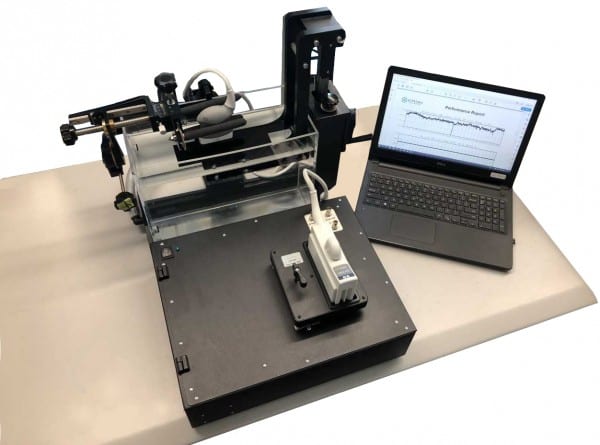Ultrasound Quality Control and Testing Best Practices

Ultrasound equipment is a complex technology, and like any other medical technology, ultrasound probes and related components can succumb to malfunction. Because of their critical role in medical diagnosis and treatment, it’s imperative that ultrasound systems benefit from the highest levels of quality control and testing.
How can diagnosticians and healthcare organizations prioritize the maintenance, repair, calibration, and continued efficacy of these systems? It comes down to best practices.
Ultrasound equipment best practices
The U.S. Food and Drug Administration (FDA) provides guidelines and regulations for medical device maintenance, including for ultrasound equipment. These regulations include requirements for quality control, calibration, and servicing intervals. On top of government regulatory standards, other professional societies and associations, including the American Institute of Ultrasound in Medicine (AIUM) and the Radiological Society of North America (RSNA), recommend additional best practices.
Comprehensively, regulatory guidelines and best practices align to focus on the most important components of ultrasound equipment maintenance, which encompass the following:
- Regular maintenance. Ultrasound equipment should be subject to a comprehensive maintenance schedule, including regular calibration, servicing, and software updates. Adhering to manufacturers’ recommendations and guidelines helps ensure optimal performance in alignment with regulatory standards.
- Routine testing. Regular testing of ultrasound transducers helps to prevent defects or degradation in image quality. This includes visual inspections, electrical tests, and assessment of acoustic performance using specialized phantoms.
- Phantom testing. Phantoms — which are artificial tissue-mimicking materials — help evaluate the performance of ultrasound systems and probes. Phantoms simulate the acoustics of human anatomy and specific pathologies and can help assess image resolution, penetration, uniformity, and other important imaging parameters.
- Organizations should maintain a comprehensive record of all quality control activities, including equipment maintenance, calibration, testing results, and any corrective actions taken. This documentation is essential for audits, accreditation, and identification of trends or issues over time.
- Regulatory compliance. Regulations and guidelines pertaining to ultrasound quality control are ever-changing. Organizations need to be aware of and comply with accreditation requirements as they evolve. Compliance failures could result in repercussions from The Joint Commission (TJC) or other accrediting bodies.
Underpinning these equipment management best practices is the need to train staff to recognize signs of malfunction and create a culture of accountability that prioritizes equipment servicing — early and often.
QC and testing for better patient safety
Why so many standards and prescribed best practices? Prioritizing patient health and safety is the goal. Safe, effective ultrasound equipment results in:
- More accurate diagnoses. Ultrasound quality control practices help healthcare professionals make accurate diagnoses. Clear, detailed images enable them to detect and identify abnormalities or other medical conditions promptly. Accurate diagnoses lead to appropriate and timely treatments.
- Minimized misdiagnoses. Regular quality control checks and adherence to standardized protocols help minimize errors and reduce the risk of misdiagnosis. Detecting and addressing issues with equipment or imaging techniques can prevent results that lead to incorrect diagnoses or unnecessary procedures.
- Better patient outcomes. Reliable imaging is essential for guiding interventional procedures, such as biopsies or catheter placements. Quality control practices ensure imaging systems provide accurate, real-time guidance during these procedures, minimizing the risk of complications.
- Fewer repeated exams. Repeat examinations can be uncomfortable for patients, causing additional anxiety and increased healthcare costs. Implementing quality control practices helps avoid inconclusive or inadequate images, reducing the need for repeat scans.
The functionality of ultrasound equipment and the integrity of the imaging it provides have a direct impact on physicians’ ability to diagnose and treat patients.
ATLAS for acoustic measurement and calibration
Acertara’s patent-pending ATLAS acoustic measurement technology is the result of over 20 years of acoustic testing and research and development, and is used by OEMs on a worldwide basis.
This table-top-sized ultrasound probe testing and analysis device provides a comprehensive breakdown of essential acoustic and electrical performance parameters of ultrasound probes, along with the detection of dead elements. ATLAS replaces the need for multiple interconnected test devices by offering high testing sophistication and functionality in a single compact package — providing precise, professional-grade array and transducer measurement capabilities compatible with any electronic array probe.
Choosing the right vendor to service your ultrasound technology brings a multitude of benefits, including:
- Equipment longevity and efficacy. We provide defect detection and repair services prior to new equipment’s arrival at your healthcare facility, leading to a longer lifespan, lower overall costs, and a reduced need for frequent service. By identifying and repairing any defects, we ensure equipment will perform at optimal levels to provide accurate and reliable results.
- Diagnostic integrity. Detecting and addressing issues before they’re passed on to the customer verifies that the equipment provides accurate and reliable diagnostic results. This integrity is invaluable in linking high-confidence assessment to better patient outcomes.
- Clinician confidence and a positive patient experience. Certifying equipment as functional and trustworthy reduces equipment failures that could impact or disrupt the patient experience. It also provides clinicians with confidence that their equipment will perform as expected when needed.


